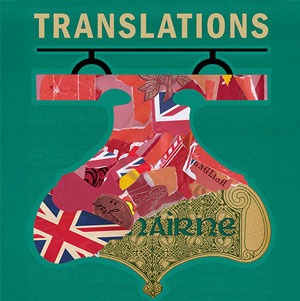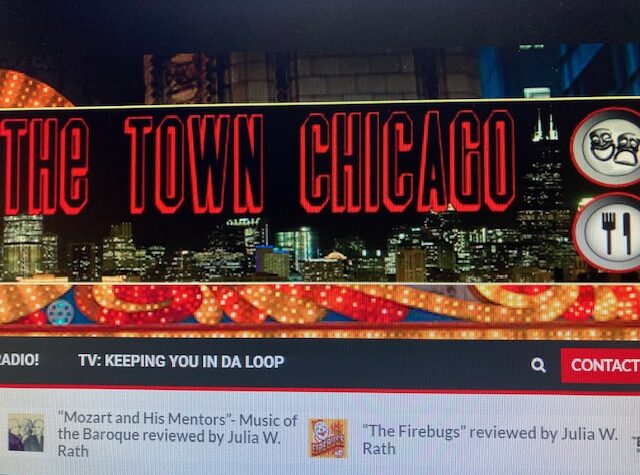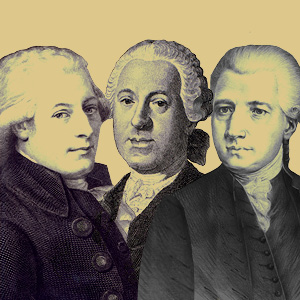
 Recommended *** Sweet and sentimental, “It’s a Wonderful Life, Live in Chicago!” is a feel-good presentation, based on the Frank Capra movie about man’s midlife crisis of faith. The point of the stage play is to evoke memories of the iconic film, of childhood, of warmth, of Christmas: things that make people joyous during the holiday season.
Recommended *** Sweet and sentimental, “It’s a Wonderful Life, Live in Chicago!” is a feel-good presentation, based on the Frank Capra movie about man’s midlife crisis of faith. The point of the stage play is to evoke memories of the iconic film, of childhood, of warmth, of Christmas: things that make people joyous during the holiday season.
As we take our seats, the audience is treated to a musical performance. We are encouraged to sing popular carols. Then there is a “guess the song” game, followed by a barbershop quartet. Once everybody is placed in a happy mood, it’s time for the main act.
The first thing the audience becomes aware of is that the stage version takes place within the context of a 1944 radio show. We become the studio audience at a live broadcast on WABT, or the Chicago affiliate of American Blues Theatre. We watch in fascination as radio cast members speak into on-air microphones and alter their versatile voices to depict all of the numerous and sundry characters from the classic drama. Brandon Dahlquist does a wonderful Jimmy Stewart imitation in his role as George Bailey. Gwendolyn Whiteside (who is also the director and artistic director for this production) performs as Mary Bailey, among other characters. Dara Cameron plays Violet; Ian Paul Custer plays Harry Bailey; James Joseph plays Uncle Billy; and John Mohrlein is especially enjoyable to watch as both Clarence the angel and the greedy Mr. Potter, two diametrically opposed characters. Music director Michael Mahler is the program announcer, plays piano throughout, and on occasion, doubles as one of the voices. Foley artist Shawn J. Goudie provides all of the foreground and background sounds necessary to create the atmospherics and spur a vivid scene in a listening audience’s imagination.
Throughout the show, I lived through my memories of the 1946 movie. Most notable is the famed phone call with Sam Wainwright when George and Mary share a telephone (although in this production, they share a microphone). Another highlight is when George gives his own money away during the bank run when the Bailey Brothers’ Building and Loan initially appears to have gone bust—and investors demand small amounts to tide them over. These depictions are well done and easy to follow, because they express simple ideas. But when the original script is transformed into a radio broadcast, problems are introduced. We miss a good deal while we are busy picturing the characters and scenes from the movie version and making comparisons. Then too, those who have never seen the movie before (or don’t recall it well) have no point of reference for the action. They will be barely able to follow the plot, as too much is going on at once. There are far too many characters to keep track of; the script contains too many scenes; and the timeline spans too many decades. There are also differences between the real universe and the alternate one that need to be followed, not to mention all the subplots and nuances that feed into the larger story. 
Put more bluntly, this particular script doesn’t lend itself to good radio. The story is much too complicated to visualize well. As a result, the performance zooms by, and we become overwhelmed. We lose the big picture in the face of tracking minor characters and subplots. A less ambitious, more straightforward plot with fewer characters would have helped, but that change would have ruined the story; it would not be the same anymore. Most importantly, this adaptation diminishes the main reason behind what has made the film a classic: namely, its focus on the ultimate question of how just one person can make a difference in transforming the world. With little or no break in the dialogue to allow us to absorb the tale, we cannot fully dwell on its basic meaning.
Having the actors read from scripts means that they must constantly look down, creating a certain distance between them and the (real) audience directly in front of them. The cast thus becomes much too removed to catch people’s eyes and have the right timing to make a joke funny or a scene memorable. This lack of engagement makes the performance very flat: ironically, reminiscent of the flatness of the celluloid medium, where the actors on screen (for obvious reasons) have no capability of engaging with their viewers.
Another fault of the production is the poor use of the screen in the background. Rather than change the sign from one design of “It’s a Wonderful Life, Live in Chicago!” to another, it would be much better to put up a sequence of black and white slides behind the actors, reminiscent of scenes from the movie. One of the more apt slides would be the picture where George lassos the moon. Another slide could be the dilapidated house, and later on, the fixed-up one where they celebrate Christmas together, and so on. At the very least, the years could be posted to provide a framework for the story. “That’s not radio,” one could argue. “A radio audience would not see this.” Yes, but a radio audience cannot see actors pretend to throw punches or act like they are physically hurt, etc. In fact, when such actions take place on stage, they serve the presentation well.
The best parts are the add-ons. I loved the old-fashioned commercials, especially for Chicago institutions like the Northern Trust Bank. The jingles composed by Michael Mahler make spirits light. Highest marks go to score composer Austin Cook, who binds the play together with music that enervates and excites, appropriate to the time period.
Grant Sabin’s set is lovely and traditional, adding to the feel-good ambiance. The fitting seasonal costumes, designed by Christopher J. Neville, add to the winter holiday theme. In the lobby afterwards, cast members treat the audience to milk and cookies. Of course, we are all awaiting Santa Claus to help with all of that, but he hasn’t come down the chimney just yet.
The radio version of “It’s a Wonderful Life” has been running in Chicago for eighteen years. So who am I to argue with success? But to my mind, it is too superficial, sentimental, and bland, not to mention confusing. We lose the magic of the original fantasy. Above all, this adaptation cannot stand the test of time and cannot stand on its own. On the positive side, the show is cheery and fun. Many will savor its charm as part and parcel of their Christmas celebration.
“It’s a Wonderful Life, Live in Chicago!” is currently playing at the Pro Theatre at Stage 773, 1225 W. Belmont Avenue, Chicago, through January 4, 2020.
Tickets are $19-$69.
The performance schedule is as follows:
 Thursdays: 7:30 p.m. (No performance on Thanksgiving Day, November 28)
Thursdays: 7:30 p.m. (No performance on Thanksgiving Day, November 28)
Fridays: 7:30 p.m.
Saturdays: 4:30 p.m. and 7:30 p.m. (No 7:30 p.m. performance on January 4)
Sundays: 2:30 p.m. (No 2:30 p.m. performance on December 8)
Additional performances: Friday, November 29 at 4:30 p.m. and Sunday, December 8 at 7:30 p.m.
Sensory-friendly performance on Sunday, December 1 at 2:30 p.m.
Touch tour performance on Sunday, November 24 at 2:30 p.m. (Touch tour at 1:30 p.m.)
Arrive 10 minutes early for prizes and audiograms.
Children 12 and under receive keepsakes on December 21 at 4:30 p.m. (Santa visits) and December 28 (Hanukkah) EDITOR NOTE: Santa will do the initial sing-alongs along with his ABT “Family” a tradition, just as this show is- in Chicago.
For tickets, buy online at AmericanBluesTheater.com or by calling 773-654-3103.
To see what others are saying, visit www.theatreinchicago.com, go to Review Round-Up and click at “It’s A Wonderful Life: Live In Chicago”.![]()






More Stories
“Translations”
“The Firebugs” reviewed by Julia W. Rath
“The Book of Grace” Al Bresloff with another from Paul LIsnek